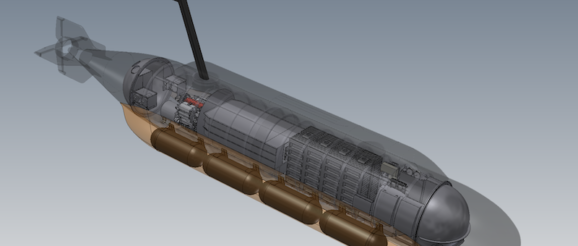Public Design Competitions Accelerate Open Innovation for Autonomous Underwater Vehicles – News

Autonomous underwater vehicles (AUVs) have become a technology of increasing interest for maritime security and surveillance applications. With a need to rapidly improve their fleets’ functionality, performance, power efficiency, and size, governments around the world are routinely calling for public contributions to research to accelerate AUV development.
The rapidly growing AUV market is being driven beyond military applications such as intelligence, surveillance, and reconnaissance (ISR), mine countermeasures (MCM), and anti-submarine warfare (ASW). AUVs can also offer collaboration with manned vehicles.
A conceptual graphic of unmanned vehicles in underwater surveillance applications. Image used courtesy of Terracciano, Bazzarello, Caiti, A. et al. Marine Robots for Underwater Surveillance. Curr Robot Rep 1, 159–167 (2020). [CC BY 4.0]
The United States’ DARPA (Defense Advanced Research Projects Agency) has made open calls for innovators to join tailored competitions for years, including the recent Subterranean Challenge, which fostered the development of autonomous vehicles for subterranean environments, and the SHRIMP Competition, which challenged designers to create micro-robotics.
In a similar vein, the UK’s Royal Navy has put out a call for teams to develop technologies to advance the creation of AUVs.
Existing Capabilities of AUV Technology
While AUVs can accomplish a wide range of missions, they have to do so in a harsh environment with restricted human intervention. Conventional electromagnetic waves used for the communication of terrestrial autonomous vehicles (AVs) are unsuitable in aquatic environments. Meanwhile, a high-density energy source is required with enough power to drive deep-sea sensors.
Rendering of the XLUUV/Manta/S201. Image used courtesy of MSubs
Why Governments Are Calling for Public Contribution
Governments worldwide are aware of the growing need for undersea operational awareness and payload delivery. Future capabilities in this area are crucial to ensure missions can be performed with reliability. However, while there have been many improvements in the capabilities of AUVs, there is a significant lack of options in the underwater battlespace.
The UK government’s Uncrewed Underwater Vehicle Testbed competition, part of the latter stage of the Developing the Royal Navy’s Underwater Capability competition, aims to trial innovative sensors and payloads on an extra-large, uncrewed underwater vehicle (XLUUV). The aim is to help the Royal Navy innovate for the next generation of underwater capabilities, fully understand the operational boundaries of AUV systems and increase the number of delivery-ready platforms available.
By calling upon the general public to contribute to AUV research and development (R&D), governments are providing innovators in industry and academia the chance to develop and test any technology they have that is aligned with future capabilities. With prudent prototyping, experimentation, and demonstration, governments have a chance of unlocking and incorporating cutting-edge capabilities into AUV development.
Soliciting technological innovations from institutions in an open forum enables governments and organizations to tap into external sources and diversify R&D investments. However, creating an open forum brings both advantages and disadvantages.
Pros and cons of open vs. closed innovation models. Image used courtesy of Nunes and Abreu. [CC BY 4.0]
Whether used for exploration, research, military or defense, advanced technologies used in autonomous submarines will continue to be developed. The continual commitment from governments to drive AUV development is sure to spur innovation, as will competition in the subsea arena, with countries such as the US Navy having a substantial budget to create a more distributed fleet architecture.
Open innovation will certainly enable governments to exploit diversity and increase knowledge. However, an open forum is a trade-off between the likelihood of a breakthrough and the probability of failure.
